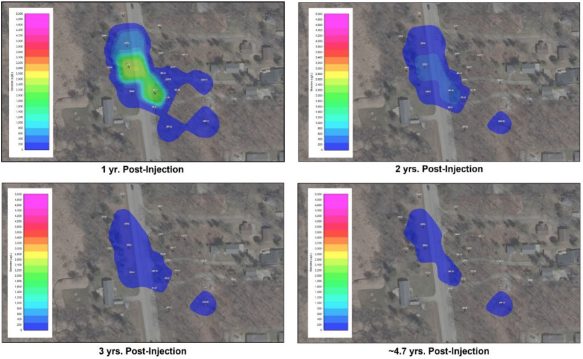SUMMARY
In 2015, a gasoline transport tanker struck a parked trailer on the shoulder of a rural highway, causing a release of up to approximately 4,000 gallons of fuel near major surface water features. Initial response activities included soil excavation, resulting in removal of approximately 1,100 tons of impacted soil. Subsequent installation and sampling of groundwater monitoring wells indicated contaminant plume expansion. In 2017, AST was tasked to perform two phases of work: Phase 1 consisted of a remedial design, which included a remedial design characterzation (RDC) to refine the Conceptual Site Model (CSM) using the resulting quantified high resolution site characterization (qHRSC) data. Phase 2 was completed in 2018, consisting of installation of a series of six BOS 200® permeable reactive barriers (PRBs) to capture and treat LNAPL and dissolved plume gasoline impacts within the saturated soil and groundwater. Positive indications of continued biological degradation of the petroleum impacted groundwater is apparent in the post-injection performance monitoring data.


Gasoline Tanker Truck Rollover Remediated using BOS 200® Permeable Reactive Barrier
CHALLENGES AND OBJECTIVE
The primary challenges were protecting nearby surface water bodies and accessing the areas of contamination due to the presence of a US highway, and multiple buried utilities (gas, water, fiber, and other communication lines) surrounded by heavily treed residential properties. The primary objective of the remedial effort was to reduce LNAPL saturation and enhance the reduction of petroleum hydrocarbon mass by establishing a platform for carbon adsorption that can manage the LNAPL in the short term, while allowing long-term treatment of dissolved phase hydrocarbon mass utilizing the BOS 200® biological processes.
APPROACH
The RDC data were instrumental in the development of a quantitative CSM for the LNAPL source and solute plume. From the quantitative RDC data it was determined that LNAPL level contaminant mass remained under the highway sorbed into a natural peat layer. The RDC included the installation of 21 borings with soil samples analyzed every 2 vertical feet and 10 temporary monitoring wells to supplement the groundwater data from 14 existing wells. The RDC also included determining the groundwater flow characteristics (hydraulic conductivity and gradient) through completion of rising and falling head slug tests in seven of the existing wells and completion of a location and elevation survey of all site features and RDC data collection points. Full-scale remedial injections included installation of 42,700 lbs of BOS 200® and 30,800 lbs of supplemental gypsum in approximately 665 injection points using direct push techniques (DPT). Also, angled DPT were used along both sides of the highway to target mass residing beneath it. Performance monitoring has consisted of collection and analysis of groundwater samples from the 14 groundwater monitoring wells on a semi-annual basis. Resulting data are used to calculate total contaminant mass reduction.
RESULTS
Performance monitoring over more than 4 years has demonstrated the continued biological degradation of petroleum hydrocarbons in groundwater. Contaminants of concern mass reduction was 94% at 1,700 days post-injection. The series of six PRBs has been sufficiently protective of the nearby surface water bodies by preventing further migration of dissolved phase contaminant mass in groundwater and reducing contaminant mass concentrations in the source area.
PROJECT SNAPSHOT
Key Dates
- 2015: Transport tanker released approximately 4,000 gallons of gasoline on rural highway shoulder. Emergency response included surface cleanup and excavation of more than 1,100 tons of impacted soil
- 2016-2017: Fourteen (14) groundwater monitoring wells installed and sampled, identifying expanding plume conditions
- 2017: A remedial design characterization (RDC) was completed to supplement historical data and to quantitatively define contaminant mass in the saturated soil and groundwater
- 2018: In-situ injections BOS 200® where source area treatment and permeable reactive barriers (PRBs) were completed, followed by more than 4 years of performance monitoring
Contaminants:
- BTEX, 1,2,4-trimethylbenzene and naphthalene (Total BTEXTriN)
Selected Remedial Technology:
- Trap and Treat®
- BOS 200®
Implementation Method:
- Direct push injection
Contaminants of Concern Mass Reduction:
- 94% at 1,700 days post-injection

Figure 1. Six Months Pre-Injection, Benzene in Groundwater Concentrations

Figure 2. Post-injection Benzene in Groundwater Concentrations






